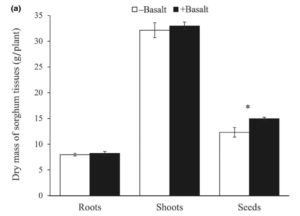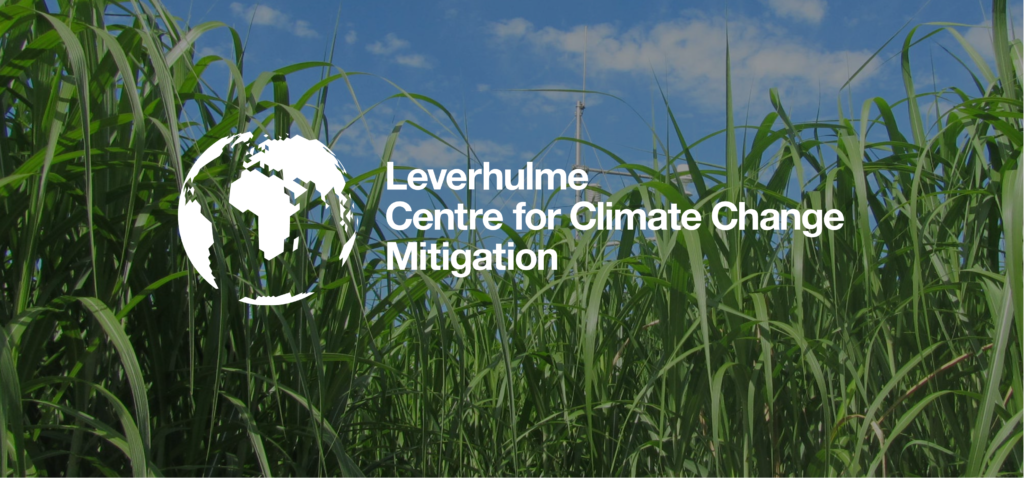Basalt Rock Dust Increases Carbon Capture Fourfold
“I’d say the biggest take-home message is that this strategy has legs. This strategy is looking good—has good prospects, both for increasing yields and for carbon dioxide removal.”
–Mike Kelland
By incorporating finely crushed basalt rock dust — and all its attendant minerals — into agricultural soils, a research team within the Leverhulme Centre for Climate Change Mitigation in the University of Sheffield in the UK has demonstrated a method of improving crop yield while sequestering excess carbon from the atmosphere.
The advent of climate change has made developing carbon capture technologies a chief concern for scientists, governments, and populaces around the world. All the extra carbon that human activities have put into the atmosphere provides both great need and ample opportunity to test out these technologies. Chances are, we’ll need more than a few of them to confront the climate change conundrum. One partial solution may just depend on our treatment of the world’s soils — particularly those used to produce its food supply.
When it comes to tackling the twin problems of feeding the world’s population and keeping climate change in check, few proposed approaches are as attractive as soil remineralization. Introducing the right minerals into soils provides both nutrients for the plants they house and elements that react with carbon dioxide (CO2), pulling it out of the air and into the ground.
Mike E. Kelland, one of the team members, was drawn to remineralization because of its carbon capture capabilities; but he soon discovered it could kill two birds with one (or rather, several tons of pulverized) stone.
“My main interest is in terms of climate change mitigation,” he says. “But we also need to think about the fact that there’s going to be another two billion people on earth in thirty years or so. So we’ve got two big problems that we need to tackle there: climate change and population growth—we need to feed quite a lot more people. These are substantial problems that we face this century.”
In a report published this year in the journal Global Change Biology, Kelland and his colleagues determined that, over the course of 120 days, the application of basalt rock dust increased crop yield by 21 percent (give or take 9.4 percent) when compared with plants in untreated soil. At the same time, the powdered rock introduced enough minerals to pack away two to four tons of atmospheric carbon dioxide per hectare (an area about the size of a baseball field) over the course of five years. This is a fourfold increase from the capability of run-of-the-mill agricultural soil on its own. That carbon, moreover, won’t be going anywhere anytime soon: carbon captured by basalt rock dust is estimated to remain trapped — removed from the atmospheric portion of the carbon cycle — for centuries. CO2 in the air reacts with rock dust to produce bicarbonate and cations. According to Dr. Tom Goreau, “The bicarbonate and cations are dissolved and ultimately flushed into groundwater, rivers, and into the sea, which stores bicarbonate until it gets removed biologically to form sediment organic carbon and limestone, which are the long term geological sinks.” That scale goes up to millennia for those carbonates that eventually dissolve and make their way to the ocean.
“We pretty clearly demonstrated the transfer of cations from the rock into, not just the plant, but into the cation-exchange complexes within the soil,” Kelland says. “This is pretty significant stuff.”

Growth results from the study, with and without basalt. Effect of basalt-amended soil on yield and chemistry of Sorghum biomass.
“It’s the cations that ultimately keep the dissolved carbon dioxide held in groundwater and rivers, until it gets to the ocean,” he adds. If soil treatments don’t introduce cations to absorb carbon, “then eventually that carbon will just outgas back into the atmosphere.” And while even standard agricultural treatments, such as lime, introduce these cations, silicate rocks (like basalt) do so more—pound for pound, they’re twice as effective as carbonate rocks (like limestone). Where carbonate rocks are roughly carbon neutral—consuming the same amount of carbon that is eventually outgassed—silicate rocks consume two times as much as is outgassed in the end. It’s the positively-charged minerals in rock dust that make remineralization work to create carbon sinks in soil—both agricultural and otherwise.
The experiment is an example of “enhanced rock weathering.” In the natural course of events, rocks are weathered into smaller particles all over the world (albeit at a glacial pace), playing their part in the carbon cycle by absorbing CO2 and stashing it away, particle by tiny particle, in soils, the ocean floor, and eventually Earth’s crust. In the process of enhanced weathering, the pace is ratcheted up enormously by crushing rock into a fine powder for remineralizing forest and agricultural soils.
There is a price for accelerating this process, though, in the form of carbon emissions. Those two to four tons of sequestered carbon in each hectare have contributed to the emissions of 0.2 to 1.2 tons of carbon needed to mine, grind, distribute, and spread all that rock dust. In other words, enhanced weathering is exponentially quicker than natural weathering (and more convenient, since the rock powder can be put exactly where needed), but takes a 10-30 percent cut of the carbon captured in emissions needed to make the process possible. There is a convenient caveat though: the aggregate industry already produces powdered rock as a byproduct—there is abundant rock dust already available for the taking.
“There’s a lot of waste material produced by the aggregate industry and mining industries worldwide, and much of that may be suitable for rock weathering,” Kelland says. “You could certainly save energy—considerable amounts of energy—by using rock that’s already been pulverized.”
While enhanced weathering can be applied to many varieties of rock, basalt is particularly useful for plants because it introduces at least six of their necessary nutrients (potassium, phosphorus, calcium, magnesium, iron, and manganese), without the high levels of potentially toxic nickel and chromium found in some other silicate rock dusts. This last point is especially important in agricultural soils, whose final product is destined for human or livestock (and thence human) consumption.
“As the studies get bigger, and as interest grows in this kind of approach, we’ll need to do a lot more analysis of the source material,” Kelland says. “It’s very important. You want to know not only that you can capture carbon, but that it also delivers these other agronomic benefits.” While basalt is not as reactive as alternative materials with more nickel and chromium—necessitating more dust for an equivalent carbon-capture capability—it’s also more widely available and, crucially, healthier for plants and humans alike.
Rock dust as an alternative fertilizer is already a staple in organic farming, according to the study, and may even act as a mild pesticide: results suggest farmers employing rock dust may expect “potential benefits for crop resistance to biotic and abiotic stress,” though the researchers call for more study into this possible effect.
Grasses like sorghum, the cereal crop studied, absorb and use silicon in the soil to strengthen their resistance to a variety of agronomic grievances. “Silicon has beneficial effects for a range of different plants; not just fungal pathogens, but also to resist pests,” Kelland says. “It also can increase the strength of the stem, to prevent plants from being tipped over or blown over in the wind.” In this study, the basalt dust introduced a prolific source of the element, enabling the plants to absorb 26 percent (give or take 5.4 percent) more silicon than in the control group.
Healthier plants are naturally more resistant to insect predation, but rock dust can directly disturb the pests as well, by interfering with their waxy protective covering that normally keeps them from drying out. Pests irritated this way soon become scarcer among the crop.
“There’s not one single panacea” to the twin challenges of climate change and population growth, Kelland says. “Most of the strategies that we propose for carbon dioxide removal require some leaps in technology or just tremendous amounts of cash in order to get them to work. If you have a strategy that can give you something else as well as carbon dioxide capture, that makes it more desirable. I think enhanced weathering is one of those strategies.”
Natasha Strydhorst studied science journalism at Boston University and Writing and Environmental Studies at Calvin College. She is on the cusp of beginning a Ph.D. program in science communication. Her goal is to address, through her studies and work, science illiteracy—bringing a greater understanding of and curiosity for science into the public realm. Natasha enjoys reading, writing, the great outdoors, and virtually any combination thereof. She looks forward to expanding her own and others’ understanding of remineralization science.
Editor’s Note: This article was updated on July 12, 2020, to more accurately describe the process by which rock dust leads to carbon sequestration.
Support us on Patreon
Thank you for joining us today! Please become a member of RTE and support us on Patreon. Unlike many larger organizations, we work with a team of determined and passionate volunteers to get our message out. We aim to continue to increase the awareness of remineralization to initiate projects across the globe that remineralize soils, grow nutrient dense food, regenerate our forests’ and stabilize the climate – with your help! If you can, please support us on a monthly basis from just $2, rest assured that you are making a big impact every single month in support of our mission. Thank you!










MJK
July 7, 2020 (10:54 pm)
Yeah I have a big garden in Burlington VT I would love to have a supply of basalt rock dust. Do Us all a favor and investigate where you can acquire this mineral locally. I like to be self sufficient so I ‘m not up to giving my money away for a small portion of my earth. I would like to make a pulverizer so I can create my own supply of minerals. Doing bio char already but minerals that’s the grand wazoo! Do something useful for us and help get the sources of minerals. Theory and reading info doesn’t help we need resources…. and free after all it is our planet isn’t it.
Joanna Campe
July 12, 2020 (2:44 pm)
I do recommend Rock Dust Local as far as sources, but you can also look for a local quarry. Download our rock dust primer on our home page to learn about the best way to find a local source.
sonia faruk
March 26, 2023 (7:07 am)
Wonderful blog you have here, but I was wanting to know if you knew of any user discussion forums that cover the same topics discussed here?
I’d really love to be a part of online community where I can get comments from other knowledgeable people that share the same interest. If you have any suggestions, please let mee know. Many thanks!
Joanna Campe
March 26, 2023 (10:10 am)
Yes! You can join our online community at http://remineralize3.ning.com/.
Rufat
June 25, 2024 (7:24 am)
I would recommend you basalt rock dust organic fertilizer from Azerbaijan. It is very high quality product, It has certificates from UK, EU, and also registered in Britain trademark.
Rufat
June 25, 2024 (9:04 am)
I would recommend you basalt rock dust organic fertilizer from Azerbaijan. It is very high quality product, It has certificates from UK, EU, and also registered in Britain trademark. Also, you can visit our website: http://www.azerbazalt.com